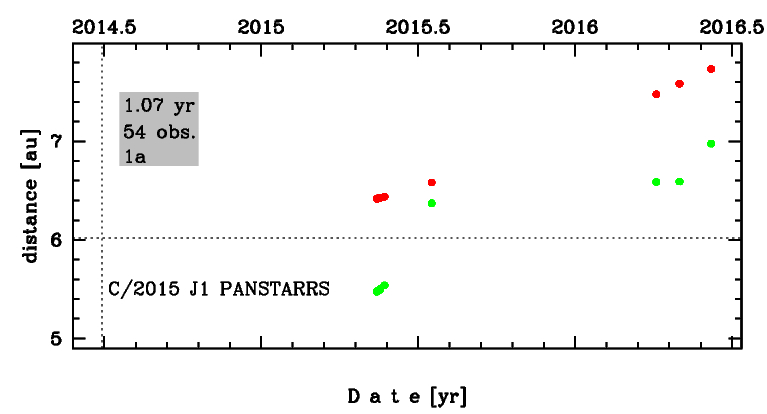C/2015 J1 PANSTARRS
more info
Comet C/2015 J1 was discovered on 14 May 2015 with Pan-STARRS 1 telescope (Haleakala), that is about 10.5 months after its perihelion passage.This comet was rather rarely observed until 7 June 2016.
Comet had its closest approach to the Earth on 15 May 2014 (5.421 au), about 1.5 months before its perihelion passage. At the moment of its discovery the comet was about 2 weeks after its second close encounter with the Earth (5.428 au on 27 April 2015).
Solution given here is based on data spanning over 1.07 yr in a range of heliocentric distances from 6.42 au to 7.73 au.
This comet suffers slight planetary perturbations during its passage through the planetary system; have orignal semimajor axis shorter than 10000 au and slightly tighter future orbit. (see future barycentric orbit).
Comet had its closest approach to the Earth on 15 May 2014 (5.421 au), about 1.5 months before its perihelion passage. At the moment of its discovery the comet was about 2 weeks after its second close encounter with the Earth (5.428 au on 27 April 2015).
Solution given here is based on data spanning over 1.07 yr in a range of heliocentric distances from 6.42 au to 7.73 au.
This comet suffers slight planetary perturbations during its passage through the planetary system; have orignal semimajor axis shorter than 10000 au and slightly tighter future orbit. (see future barycentric orbit).
| solution description | ||
|---|---|---|
| number of observations | 54 | |
| data interval | 2015 05 14 – 2016 06 07 | |
| data type | observed only after perihelion (POST) | |
| data arc selection | entire data set (STD) | |
| range of heliocentric distances | 6.42 au – 7.73au | |
| detectability of NG effects in the comet's motion | NG effects not determinable | |
| type of model of motion | GR - gravitational orbit | |
| data weighting | YES | |
| number of residuals | 104 | |
| RMS [arcseconds] | 0.33 | |
| orbit quality class | 1a | |
| previous orbit statistics, both Galactic and stellar perturbations were taken into account | ||
|---|---|---|
| no. of returning VCs in the swarm | 5001 | * |
| no. of escaping VCs in the swarm | 0 | |
| no. of hyperbolas among escaping VCs in the swarm | 0 | |
| previous reciprocal semi-major axis [10-6 au-1] | 112.81 – 119.11 – 125.37 | |
| previous perihelion distance [au] | 6.02009 – 6.02067 – 6.02143 | |
| previous aphelion distance [103 au] | 15.9 – 16.8 – 17.7 | |
| time interval to previous perihelion [Myr] | 0.712 – 0.768 – 0.834 | |
| percentage of VCs with qprev < 10 | 100 | |
| previous_g orbit statistics, here only the Galactic tide has been included | ||
|---|---|---|
| no. of returning VCs in the swarm | 5001 | * |
| no. of escaping VCs in the swarm | 0 | |
| no. of hyperbolas among escaping VCs in the swarm | 0 | |
| previous reciprocal semi-major axis [10-6 au-1] | 112.81 – 119.11 – 125.37 | |
| previous perihelion distance [au] | 6.01892 – 6.0192 – 6.01957 | |
| previous aphelion distance [103 au] | 15.9 – 16.8 – 17.7 | |
| time interval to previous perihelion [Myr] | 0.712 – 0.768 – 0.834 | |
| percentage of VCs with qprev < 10 | 100 | |
